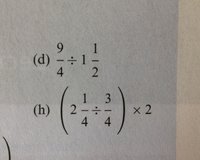LaaLa
New member
- Joined
- Dec 21, 2018
- Messages
- 21
I'm going through the fifth edition of Anthony Croft and Robert Davison "Foundation of Maths". When coming across a certain problem based on fractions, I was a little skeptical about the answer given at the ends of the book. (Further details: Pg.25 Exercise 2.5 question (h)).
Problem: (2*1/4 / 3/4) x 2
Solution: (Further details: Pg.485 Exercise 2.5. Question (h)).
(2*1/4 / 3/4) x 2 =
(9/4 x 4/3) x 2 =
(3/4 x 4) x 2 =
3 x 2 = 6.
Question: Where did the 4 come from in (3/4 x 4) x 2 ?
Here is my answer:
(2 1/4 / 3/4) x 2 =
2 1/4 = (2x4+1)/ 4 = 9/4
(9/4 / 3/4 = 9/4 x 4/3 = 36/12 = 6/2 = 3/1) x 2 =
2 x 3/1 = (2x1+3)/1 = 5/1
so 5/1
= 5
A little bit confused here...
How is my answer different to the solution in the book?
Am I missing something here?
Maybe the rules are different when the denominator is a one prehaps?
Your help is appreciated Thank you
Thank you
Problem: (2*1/4 / 3/4) x 2
Solution: (Further details: Pg.485 Exercise 2.5. Question (h)).
(2*1/4 / 3/4) x 2 =
(9/4 x 4/3) x 2 =
(3/4 x 4) x 2 =
3 x 2 = 6.
Question: Where did the 4 come from in (3/4 x 4) x 2 ?
Here is my answer:
(2 1/4 / 3/4) x 2 =
2 1/4 = (2x4+1)/ 4 = 9/4
(9/4 / 3/4 = 9/4 x 4/3 = 36/12 = 6/2 = 3/1) x 2 =
2 x 3/1 = (2x1+3)/1 = 5/1
so 5/1
= 5
A little bit confused here...
How is my answer different to the solution in the book?
Am I missing something here?
Maybe the rules are different when the denominator is a one prehaps?
Your help is appreciated

